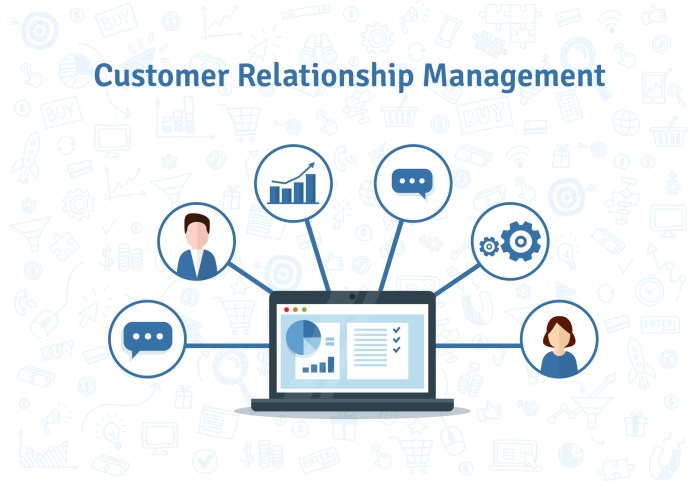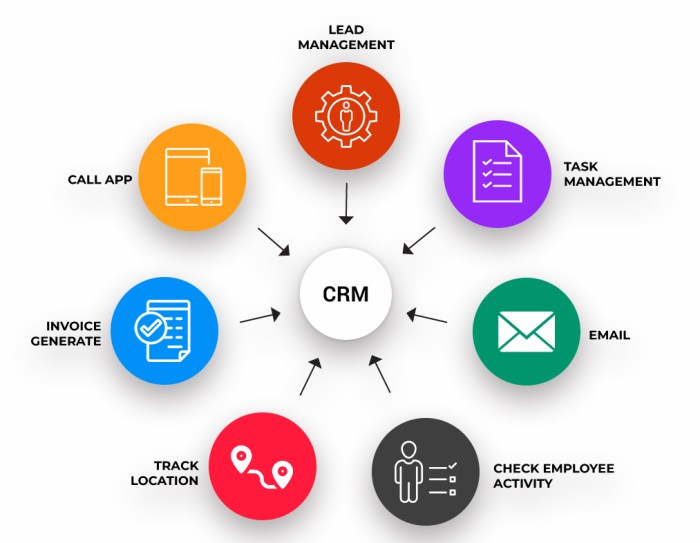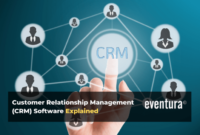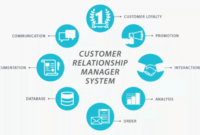Sales CRM, a powerful tool for businesses, revolutionizes how you manage customer interactions and sales processes. It centralizes all your customer data, allowing you to track leads, manage opportunities, and nurture relationships efficiently.
By implementing a Sales CRM system, you gain valuable insights into your customer base, optimize your sales strategies, and ultimately boost your revenue. This comprehensive guide will explore the intricacies of Sales CRM, from its core functionalities to its future impact on the business landscape.
What is a Sales CRM?
A Sales CRM, or Customer Relationship Management system, is a software application designed to streamline and automate sales processes, manage customer interactions, and improve overall sales performance. A Sales CRM acts as a central hub for all customer-related data, enabling businesses to track interactions, manage leads, nurture relationships, and ultimately drive revenue growth.
Core Functionalities of a Sales CRM
A Sales CRM offers a wide range of functionalities to support sales teams and enhance their efficiency.
- Lead Management:Sales CRMs provide tools for capturing, qualifying, and nurturing leads. They allow sales teams to track lead sources, prioritize prospects, and manage communication efforts.
- Contact Management:CRMs store and organize customer data, including contact information, purchase history, communication logs, and preferences. This centralized database provides a comprehensive view of each customer, enabling personalized interactions.
- Sales Pipeline Management:CRMs offer visual representations of the sales pipeline, allowing sales teams to track deals at different stages, identify bottlenecks, and forecast revenue.
- Opportunity Management:CRMs help sales teams manage opportunities, track progress, and prioritize deals based on their potential value. They provide tools for forecasting sales and analyzing performance metrics.
- Sales Automation:CRMs automate repetitive tasks such as email campaigns, appointment scheduling, and follow-up reminders, freeing up sales teams to focus on high-value activities.
- Reporting and Analytics:CRMs provide dashboards and reports to track key performance indicators (KPIs) and gain insights into sales performance. This data helps businesses identify areas for improvement and optimize sales strategies.
Purpose of a Sales CRM
The primary purpose of a Sales CRM is to enhance customer relationships and drive sales growth. It achieves this by:
- Centralizing Customer Information:CRMs consolidate all customer data in one place, providing a single source of truth for sales teams.
- Improving Communication and Collaboration:CRMs facilitate communication and collaboration among sales teams, ensuring everyone has access to the same information and can work together effectively.
- Personalizing Customer Interactions:By leveraging customer data, CRMs enable sales teams to personalize interactions and provide a more tailored experience.
- Optimizing Sales Processes:CRMs streamline sales processes, automating tasks and improving efficiency. This allows sales teams to focus on closing deals and generating revenue.
Benefits of Implementing a Sales CRM
Implementing a Sales CRM system offers numerous benefits for businesses, including:
- Increased Sales Productivity:By automating tasks and streamlining processes, CRMs free up sales teams to focus on selling. This leads to increased productivity and higher sales revenue.
- Improved Customer Satisfaction:Personalized interactions and better customer service lead to increased customer satisfaction and loyalty.
- Enhanced Lead Management:CRMs help businesses identify and qualify leads more effectively, resulting in a higher conversion rate.
- Better Sales Forecasting:CRMs provide data-driven insights into sales performance, enabling businesses to make more accurate forecasts and plan for the future.
- Stronger Customer Relationships:By fostering better communication and understanding of customer needs, CRMs help businesses build stronger customer relationships.
Key Features of a Sales CRM
A Sales CRM (Customer Relationship Management) system is designed to streamline and enhance your sales process. It does this by providing a centralized platform for managing customer interactions, tracking sales progress, and analyzing sales performance.
Types of Sales CRMs
There are different types of Sales CRMs available, each with its own unique set of features and pricing. Here’s a comparison table highlighting some key differences:
| CRM Type | Features | Pricing | Target Audience |
|---|---|---|---|
| Small Business CRM | Basic contact management, lead tracking, and reporting. | Often free or low-cost, with subscription options available. | Small businesses with limited budgets and simpler sales processes. |
| Mid-Market CRM | Advanced features such as marketing automation, sales forecasting, and customer segmentation. | Priced based on features and user count, with monthly or annual subscriptions. | Mid-sized businesses with more complex sales processes and a need for greater insights. |
| Enterprise CRM | Comprehensive features, including advanced analytics, integration with other business systems, and customizable workflows. | High-priced, with customized contracts and support services. | Large enterprises with complex sales operations and a need for scalability and customization. |
Essential Features of a Sales CRM
The core features of a Sales CRM are designed to help sales teams manage their customers, leads, and sales opportunities effectively. These features include:
- Contact Management:This feature allows you to store and organize customer information, including contact details, communication history, and purchase history. This provides a central hub for all your customer interactions.
- Lead Generation:A Sales CRM helps you capture and qualify leads from various sources, such as website forms, social media, and marketing campaigns. It helps you prioritize and nurture leads, ensuring you focus on the most promising prospects.
- Pipeline Management:This feature enables you to visualize and track the progress of your sales opportunities through different stages of the sales cycle. You can monitor the movement of leads, opportunities, and deals, allowing you to make informed decisions and manage your sales process effectively.
- Opportunity Tracking:This feature helps you monitor the progress of individual deals, tracking key metrics such as revenue potential, closing probability, and next steps. It allows you to stay on top of your deals and identify potential roadblocks.
- Reporting and Analytics:A Sales CRM provides valuable insights into your sales performance. You can generate reports on key metrics such as conversion rates, average deal size, and sales pipeline health. This data helps you identify areas for improvement and optimize your sales strategies.
Advanced Features of a Sales CRM
Some Sales CRMs offer advanced features that can further enhance your sales operations and provide deeper insights into your customer base. These features include:
- Marketing Automation:This feature allows you to automate marketing tasks, such as sending email campaigns, nurturing leads, and creating personalized content. It helps you save time and improve your marketing efficiency.
- Sales Forecasting:Sales forecasting helps you predict future sales performance based on historical data and current trends. This enables you to make informed business decisions, plan for future growth, and manage resources effectively.
- Customer Segmentation:This feature allows you to group your customers based on shared characteristics, such as demographics, purchase history, or engagement levels. This enables you to tailor your marketing and sales strategies to specific customer segments, improving your targeting and personalization efforts.
- Social Media Integration:Some CRMs integrate with social media platforms, allowing you to track social media mentions, manage social media campaigns, and engage with your customers on social media. This helps you build relationships with your customers and stay connected to their online activities.
Choosing the Right Sales CRM
Selecting the right Sales CRM is crucial for any business that wants to streamline its sales processes, improve efficiency, and boost revenue. It’s not a one-size-fits-all solution, as the ideal CRM depends on various factors specific to your business.
Factors to Consider When Choosing a Sales CRM
Choosing the right Sales CRM requires careful consideration of your business needs. Several factors should be taken into account to ensure the CRM aligns with your goals and processes.
- Business Size:Small businesses might require a simple and affordable CRM with basic features, while larger enterprises need a more robust solution with advanced functionalities.
- Budget:CRMs come in a wide range of pricing models, from free to enterprise-grade solutions. It’s essential to determine your budget and find a CRM that fits your financial constraints.
- Industry:Different industries have specific needs. For instance, a CRM for a SaaS company might focus on lead generation and customer relationship management, while a CRM for a retail business might prioritize inventory management and point-of-sale integration.
- Specific Needs:Identify the specific features you need, such as lead management, email marketing, sales forecasting, reporting, and integration with other business applications.
Advantages and Disadvantages of Different Sales CRM Providers
There are several types of Sales CRM providers, each with its advantages and disadvantages. Understanding these differences can help you choose the best option for your business.
Cloud-Based vs. On-Premise Solutions
- Cloud-Based:
- Advantages:
- Accessibility from anywhere with an internet connection.
- Lower upfront costs, as you pay a monthly subscription fee.
- Automatic updates and maintenance by the provider.
- Scalability to accommodate growth.
- Disadvantages:
- Dependence on internet connectivity.
- Potential security concerns if the provider’s data centers are compromised.
- Limited customization options.
- Advantages:
- On-Premise:
- Advantages:
- Greater control over data security and privacy.
- More customization options.
- No reliance on internet connectivity.
- Disadvantages:
- Higher upfront costs for hardware and software.
- In-house IT resources required for installation, maintenance, and updates.
- Limited scalability.
- Advantages:
Open-Source vs. Proprietary Software
- Open-Source:
- Advantages:
- Flexibility and customization.
- Lower cost, as the software is free to use.
- Access to a large community of developers who contribute to the software’s development.
- Disadvantages:
- Requires technical expertise to install, configure, and maintain.
- Limited support options.
- May not be as user-friendly as proprietary software.
- Advantages:
- Proprietary Software:
- Advantages:
- User-friendly interface and comprehensive documentation.
- Strong support from the vendor.
- Regular updates and security patches.
- Disadvantages:
- Higher cost.
- Limited customization options.
- Dependence on the vendor for support and updates.
- Advantages:
Free vs. Paid Options
- Free:
- Advantages:
- No upfront cost.
- Good starting point for small businesses or those just starting out.
- Disadvantages:
- Limited features and functionality.
- May not be scalable for growing businesses.
- Limited support options.
- Advantages:
- Paid:
- Advantages:
- More advanced features and functionality.
- Scalability to accommodate growth.
- Stronger support options.
- Disadvantages:
- Higher cost.
- May not be necessary for small businesses with limited needs.
- Advantages:
Popular Sales CRM Platforms and Their Unique Features
Several popular Sales CRM platforms offer unique features to cater to different business needs.
- Salesforce:
- Features:
- Comprehensive suite of sales, marketing, and service tools.
- Highly customizable and scalable.
- Strong integration with other business applications.
- Extensive support and resources.
- Features:
- HubSpot:
- Features:
- Focus on inbound marketing and sales.
- Free and paid plans to suit different business sizes.
- Easy-to-use interface and comprehensive reporting tools.
- Strong community support.
- Features:
- Zoho CRM:
- Features:
- Affordable and feature-rich CRM.
- Offers a wide range of integrations.
- Strong automation capabilities.
- Comprehensive reporting and analytics tools.
- Features:
- Microsoft Dynamics 365:
- Features:
- Integrated with Microsoft Office 365 applications.
- Powerful automation and customization capabilities.
- Strong focus on customer relationship management.
- Comprehensive reporting and analytics tools.
- Features:
- Pipedrive:
- Features:
- Simple and intuitive interface.
- Strong focus on sales pipeline management.
- Visual sales pipeline and progress tracking.
- Affordable pricing plans.
- Features:
Implementing a Sales CRM
Implementing a Sales CRM is a significant step for any business looking to streamline its sales processes and boost efficiency. It involves a series of carefully planned and executed steps to ensure a smooth transition and maximize the benefits of the new system.
Data Migration, Sales crm
Data migration is the process of transferring existing customer and sales data from your current system to the new CRM. This is a critical step as it ensures you have a complete and accurate picture of your sales pipeline and customer history.
- Identify Data Sources:Begin by identifying all the sources of data that need to be migrated, such as spreadsheets, databases, and legacy systems.
- Data Cleansing:Before migrating, ensure your data is accurate and consistent. This involves removing duplicate entries, correcting errors, and standardizing data formats.
- Choose a Migration Method:There are various methods for data migration, including manual entry, automated tools, and data integration services. The best approach depends on the size and complexity of your data.
- Test and Validate:After migration, thoroughly test and validate the data to ensure accuracy and completeness.
User Training
Effective user training is essential for maximizing CRM adoption and ensuring users understand how to leverage the system’s features to their advantage.
- Develop a Training Plan:Create a comprehensive training plan that covers all aspects of the CRM, including basic navigation, key features, and specific workflows.
- Offer Multiple Training Options:Provide a variety of training formats to cater to different learning styles, such as online modules, live webinars, and in-person workshops.
- Provide Ongoing Support:Offer ongoing support through user guides, FAQs, and dedicated support teams to address any questions or issues users may encounter.
Process Mapping
Process mapping helps you visualize and optimize your sales processes, ensuring they align with the capabilities of your new CRM.
- Identify Key Processes:Start by identifying the core sales processes that need to be mapped, such as lead generation, qualification, opportunity management, and closing deals.
- Document Current Processes:Document your existing sales processes in detail, including steps, decision points, and responsibilities.
- Map Processes to CRM Features:Analyze your documented processes and map them to the corresponding features and functionalities of the CRM.
- Optimize and Streamline:Identify areas for improvement and streamline processes based on the CRM’s capabilities.
Integration with Existing Systems
Integrating your CRM with other existing systems, such as your email marketing platform, accounting software, and marketing automation tools, can significantly enhance efficiency and data flow.
- Identify Integration Needs:Begin by identifying the systems that need to be integrated with your CRM.
- Choose Integration Methods:There are various integration methods available, including API integrations, data connectors, and third-party applications.
- Test and Validate:After integration, thoroughly test and validate the data flow between systems to ensure accuracy and seamless communication.
Using a Sales CRM Effectively

A Sales CRM is a powerful tool, but its effectiveness depends on how you use it. This section will explore practical strategies for maximizing your CRM’s potential, focusing on managing leads, tracking opportunities, nurturing customer relationships, and leveraging data for better decision-making.
Managing Leads
Effective lead management is the cornerstone of a successful sales process. A CRM streamlines this process by providing a centralized platform to capture, organize, and qualify leads.
- Capture Leads from Multiple Sources:Integrate your CRM with various sources like your website, social media, email marketing, and marketing automation platforms. This ensures all leads are captured and stored in one place, eliminating duplication and data silos.
- Qualify Leads Based on Predefined Criteria:Establish clear criteria for lead qualification, such as industry, company size, job title, or budget. Use CRM features like lead scoring to automatically assign points based on lead attributes, helping you prioritize the most promising prospects.
- Assign Leads to Sales Representatives:Utilize CRM workflows to automatically assign leads to the appropriate sales representatives based on their expertise, territory, or industry specialization. This ensures leads are handled by the right people, increasing the chances of conversion.
- Track Lead Interactions:Record every interaction with a lead, including emails, phone calls, website visits, and meeting notes. This provides a comprehensive history of each lead’s journey, enabling you to tailor future communications effectively.
Tracking Opportunities
A CRM transforms the way you track and manage sales opportunities. It allows you to visualize the sales pipeline, identify bottlenecks, and prioritize deals based on their likelihood of closure.
- Create Opportunity Records:For each qualified lead, create an opportunity record that Artikels the specific product or service they are interested in, the estimated value of the deal, and the proposed timeline. This provides a structured framework for managing the sales process.
- Define Sales Stages:Divide the sales process into distinct stages, such as “qualification,” “proposal,” “negotiation,” and “closed won/lost.” This visual representation of the sales pipeline helps you track the progress of each opportunity and identify potential roadblocks.
- Forecast Revenue:Use CRM reporting and analytics features to generate accurate revenue forecasts based on the current pipeline and the likelihood of closing deals. This enables you to make informed business decisions about resource allocation and sales targets.
- Collaborate on Deals:CRM collaboration tools allow you to share information and insights with other team members, ensuring everyone is on the same page regarding opportunities and their progress.
Nurturing Customer Relationships
Customer relationship management is not just about closing deals; it’s about building lasting relationships that drive repeat business and advocacy. A CRM empowers you to nurture these relationships effectively.
- Personalized Communication:Leverage CRM data to send personalized emails, newsletters, and other communications based on customer preferences, purchase history, and engagement levels. This demonstrates a genuine understanding of their needs and increases their satisfaction.
- Targeted Marketing Campaigns:Segment your customer base into different groups based on demographics, interests, or purchase behavior. This allows you to deliver targeted marketing campaigns that resonate with each segment, maximizing campaign effectiveness.
- Automated Follow-Ups:Use CRM automation features to schedule automated follow-up emails, reminders, and thank-you messages. This ensures consistent communication and builds a strong rapport with your customers.
- Track Customer Feedback:Gather feedback from customers through surveys, reviews, and social media monitoring. This provides valuable insights into their satisfaction levels and helps you identify areas for improvement.
Using Reporting and Analytics
CRM reporting and analytics features offer a wealth of data that can be leveraged to identify trends, measure performance, and make data-driven decisions.
- Track Key Performance Indicators (KPIs):Monitor key metrics like lead conversion rate, average deal size, sales cycle length, and customer lifetime value. This helps you identify areas of strength and weakness in your sales process.
- Analyze Sales Trends:Use CRM reports to analyze sales trends over time, identifying patterns and seasonality. This allows you to predict future sales performance and adjust your strategies accordingly.
- Measure Campaign Effectiveness:Track the performance of your marketing campaigns, measuring metrics like open rates, click-through rates, and conversions. This data provides insights into which campaigns are most effective and helps you optimize your marketing efforts.
- Identify Sales Opportunities:Use CRM data to identify potential sales opportunities based on customer behavior, market trends, and competitor analysis. This proactive approach helps you stay ahead of the curve and capitalize on emerging opportunities.
The Future of Sales CRM
The future of Sales CRM is bright, driven by the relentless evolution of technology and the ever-changing needs of businesses and customers. As technology advances, Sales CRMs are becoming increasingly sophisticated, incorporating artificial intelligence (AI), machine learning (ML), and predictive analytics to automate tasks, personalize interactions, and improve sales outcomes.
Impact of Emerging Technologies
The integration of emerging technologies is fundamentally reshaping the landscape of Sales CRM. AI, ML, and predictive analytics are transforming how businesses manage their sales processes, analyze data, and make informed decisions.
- AI-powered automation:AI is automating repetitive tasks like data entry, lead qualification, and appointment scheduling, freeing up sales teams to focus on more strategic activities. For instance, AI-powered chatbots can handle initial customer interactions, qualifying leads and routing them to the appropriate sales representative.
- ML-driven insights:Machine learning algorithms analyze vast amounts of data to identify patterns and trends, providing valuable insights into customer behavior and sales performance. This data can be used to predict future sales, optimize pricing strategies, and personalize marketing campaigns. For example, ML models can predict customer churn, enabling businesses to proactively intervene and retain valuable customers.
- Predictive analytics:Predictive analytics uses historical data and statistical models to forecast future outcomes, such as sales revenue, lead conversion rates, and customer lifetime value. This information allows businesses to make proactive decisions and optimize their sales strategies. For instance, predictive analytics can identify high-potential leads, enabling sales teams to prioritize their outreach efforts and maximize their conversion rates.
Evolving to Meet Changing Needs
Sales CRMs are constantly evolving to meet the changing needs of businesses and customers. This evolution is driven by several factors, including the increasing complexity of sales processes, the rise of digital channels, and the growing demand for personalized customer experiences.
- Integration with other systems:Modern Sales CRMs are designed to seamlessly integrate with other business systems, such as marketing automation platforms, e-commerce platforms, and customer support systems. This integration allows businesses to create a unified view of their customers and streamline their sales processes.
- Mobile accessibility:Sales teams are increasingly mobile, and Sales CRMs are adapting to meet this need by offering mobile-friendly interfaces and access to real-time data. This allows sales representatives to manage their leads, track their progress, and engage with customers from anywhere, at any time.
- Focus on customer experience:Sales CRMs are increasingly focused on providing a personalized and engaging customer experience. This includes features like personalized communication, omnichannel engagement, and real-time customer insights.
Key Trends Shaping the Future
Several key trends are shaping the future of Sales CRM, driving innovation and transforming how businesses interact with their customers.
- Personalization:Personalization is becoming increasingly important in sales, as customers expect tailored experiences that meet their individual needs. Sales CRMs are evolving to provide tools for personalized communication, targeted offers, and customized content.
- Customer experience (CX):Customer experience is a critical differentiator in today’s competitive market. Sales CRMs are focusing on enhancing the customer experience through seamless interactions, personalized communication, and proactive support.
- Omnichannel marketing:Customers interact with businesses through multiple channels, and Sales CRMs are adapting to support omnichannel marketing strategies. This involves providing a consistent and unified experience across all channels, including email, social media, chat, and mobile apps.
Closing Notes: Sales Crm

In conclusion, Sales CRM is a game-changer for businesses looking to enhance their sales performance and customer satisfaction. By harnessing the power of this technology, you can streamline your operations, gain valuable insights, and drive sustainable growth. As the future of Sales CRM continues to evolve with advancements in AI and automation, businesses can anticipate even more innovative solutions for optimizing their sales processes and achieving greater success.
FAQ Explained
What are some popular Sales CRM platforms?
Some popular Sales CRM platforms include Salesforce, HubSpot, Zoho CRM, Microsoft Dynamics 365, and Pipedrive. Each platform offers unique features and caters to different business needs.
Is Sales CRM suitable for small businesses?
Absolutely! Sales CRM can benefit businesses of all sizes. Many platforms offer affordable plans specifically designed for small businesses, providing them with the tools to manage their sales effectively.
How do I choose the right Sales CRM for my business?
Consider factors such as your business size, budget, industry, specific needs, and the features offered by different platforms. It’s essential to evaluate your requirements and select a CRM that aligns with your goals.




